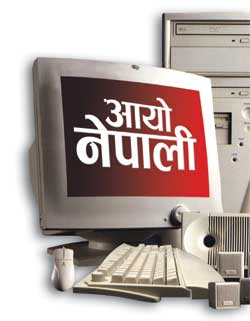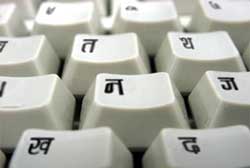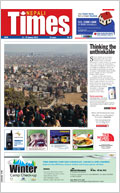 Despite a decade of talk about "leveling the playing field", allowing developing countries to "leapfrog into the information age" and "bridging the digital divide", advances in information technology haven't necessarily made the world a better place. In fact, the gap between the haves and the have nots has actually grown.
Despite a decade of talk about "leveling the playing field", allowing developing countries to "leapfrog into the information age" and "bridging the digital divide", advances in information technology haven't necessarily made the world a better place. In fact, the gap between the haves and the have nots has actually grown. One problem has been the dominance of the English language that has put the technology out of reach for those societies that have a different language or script. Computers are not by definition monolingual, if they are only to understand the binary language of 0 and 1.
The dominance of English on our screens, on the LCD displays of pagers or the brightly-lit faces of ATMs is a cultural and political phenomenon rather than a technological one. The American origins of the defining technologies can be seen in the names given to hardware and software. Despite the dreams of some enthusiasts, high-level programming languages are not likely to drop their English-based syntaxes for Sanskrit or Chinese.
Yet with the development, and now universal, reach of graphical (rather than text-based) interfaces, this need have no bearing on the end user. The potential for breaking down the language barrier and offering unlimited IT-based services in Nepali lies latent in all the under-utilised computer equipment that we see around us.
 The prospect of emailing, accounting, databasing and Internet-surfing in Nepali-and thereby at a stroke opening a world of opportunity to those outside the English-speaking upper middle classes-is no longer the stuff of dreams. For a long time it has been possible to use Devanagari fonts for Sanskrit-based languages on a variety of platforms: Windows, Mac and Unix/Linux. Developers across South Asia and elsewhere have produced attractive and functioning fonts that are currently used in a number of environments, not least for word processing and typesetting. Such work has also been taking place in Nepal since the 1980s. Yet, despite various efforts, one single problem undermines all of this work to date: there was no standard for Devanagari which meant that to read Kantipur, Gorkhapatra and Himal Khabarpatrika online one has to download and install all three separate fonts.
The prospect of emailing, accounting, databasing and Internet-surfing in Nepali-and thereby at a stroke opening a world of opportunity to those outside the English-speaking upper middle classes-is no longer the stuff of dreams. For a long time it has been possible to use Devanagari fonts for Sanskrit-based languages on a variety of platforms: Windows, Mac and Unix/Linux. Developers across South Asia and elsewhere have produced attractive and functioning fonts that are currently used in a number of environments, not least for word processing and typesetting. Such work has also been taking place in Nepal since the 1980s. Yet, despite various efforts, one single problem undermines all of this work to date: there was no standard for Devanagari which meant that to read Kantipur, Gorkhapatra and Himal Khabarpatrika online one has to download and install all three separate fonts. Without standard encoding for Devanagari (preferably combined with a standard keyboard layout to make learning to type simple) it is impossible to develop serious data processing and manipulation in Nepali. The knock-on effect on development planning in Nepal in opportunity loss is immense.
 The Nepali Font Standardisation Committee that consisted of linguists, technicians, librarians, academics and media experts made a major effort in 1997 to find a common parameter. A document detailing the font standard was prepared. The standard specified what characters must be included in any Nepali font, and how they were to be sorted. This standard was discussed during a workshop held during CAN Info Tech 1998, and given a final form. Unfortunately, the work couldn't progress ahead in the lack of technical expertise to implement it natively in computer systems.
The Nepali Font Standardisation Committee that consisted of linguists, technicians, librarians, academics and media experts made a major effort in 1997 to find a common parameter. A document detailing the font standard was prepared. The standard specified what characters must be included in any Nepali font, and how they were to be sorted. This standard was discussed during a workshop held during CAN Info Tech 1998, and given a final form. Unfortunately, the work couldn't progress ahead in the lack of technical expertise to implement it natively in computer systems. Unicode is a standard developed for computers to store the character standards developed by a worldwide consortium. Unicode contains standard encoding for, among a wide range of scripts, Devanagari. Given global acceptance of the Unicode, the standard will be adopted uncritically by the vast majority of computer users as they upgrade to newer releases of different operating systems.
If, and only if, Unicode is implemented according to the needs of the Nepali people will they then be able to compute natively in their own languages. A UNDP-supported pilot project involving the Madan Puraskar Pustakalaya, the Ministry of Science and Technology and the Computer Association of Nepal are working on a pilot project to implement a workable and potentially universal font standard for Nepali. It overcame difficulties like the lack of a standard keyboard layout. An integral part of the objective was not only to find technical solutions, but to publicise them and provide the training and education necessary to ensure their widest possible adoption and exploitation.
(Nepali Unicode fonts will be made public on 24 January at the CAN InfoTech 2003, and tutorials will be held on 27 January. Software can be downloaded for free at the website www.mpp.org.np. Since bandwidth is a problem, there is also a CD which will be available at various stalls during the CAN Info-Tech,which can also be ordered at cost price through [email protected])
RELATED ARTICLE
Cableless and wireless >>
Just do IT >>


